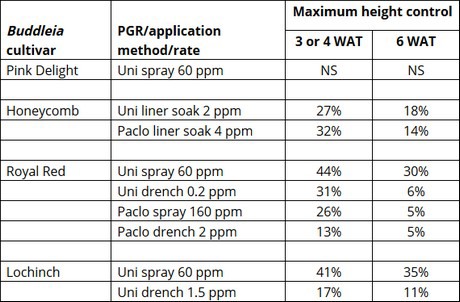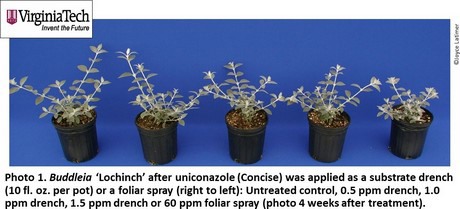Butterfly bushes (Buddleia spp.) are great perennial flowering plants to meet the current interest in pollinator gardens. These very vigorous plants are typically grown as herbaceous perennials although they become quite woody in the landscape. We’ve conducted several PGR trials with different cultivars using uniconazole (Concise, Sumagic) and/or paclobutrazol (Piccolo, Piccolo 10XC, Bonzi, Pac O) and this is a good place to summarize some of those results.
by Joyce Latimer
As with most of our herbaceous perennials, Buddleia cultivars vary in their response to PGRs (Table 1). As a very vigorous crop Buddleia requires early PGR applications. In our studies, the PGRs were applied as liner soaks prior to potting (‘Honeycomb’) or as foliar sprays or substrate drenches (10 fl. oz. per trade gallon pot) applied 10 to 14 days after potting. As you can see with the cultivars listed below, the growth response was maximized at 3 or 4 weeks after the PGR application (WAT). Much of this growth control, relative to the untreated control, was lost by 6 WAT.

Table 1. Maximum growth control(percent shorter than untreated control plants) of Buddleia species/cultivars using uniconazole (uni, Concise) or paclobutrazol (paclo, Piccolo) applied as foliar sprays, liner soaks (2 min) or drench (10 fl. oz. per trade gallon pot)as measured at 3 or 4 (depending on experiment) and 6 weeks after treatment application (WAT).
The rapid resumption of growth suggests a potential benefit to planning to make multiple applications during production. The increase in the length of the internodes as the PGR effect is lost, is a visible indicator of the need to make a second application (see photo 1). This change in elongation is clear in the Buddleia ‘Lochinch’ plant treated with 0.5 ppm substrate drench (second from left, Photo1). Also notice the significant growth control with the 60 ppm foliar spray ofu niconazole at 4 WAT which persisted through a 6 WAT measurement.

In summary, Buddleia is generally responsive to either uniconazole or paclobutrazol. However, the response varies with cultivar. Therefore, you will need to run your own trials or start with lower application rates and make additional applications as necessary. Once you narrow down the rate, consider planning on making a second application later in the crop cycle to attain season long control.
Source: eGRO Blog










